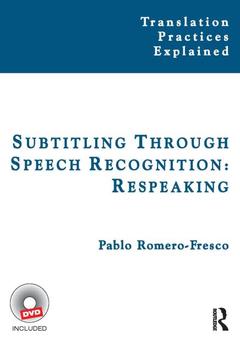Subtitling Through Speech Recognition Respeaking Translation Practices Explained Series
Auteur : Romero-Fresco Pablo

Based on sound research and first-hand experience in the field, Subtitling through Speech Recognition: Respeaking is the first book to present a comprehensive overview of the production of subtitles through speech recognition in Europe. Topics covered include the origins of subtitling for the deaf and hard of hearing, the different methods used to provide live subtitles and the training and professional practice of respeaking around the world. The core of the book is devoted to elaborating an in-depth respeaking course, including the skills required before, during and after the respeaking process. The volume also offers detailed analysis of the reception of respeaking, featuring information about viewers? preferences, comprehension and perception of respoken subtitles obtained with eye-tracking technology.
Accompanying downloadable resources feature a wealth of video clips and documents designed to illustrate the material in the book and to serve as a basis for the exercises included at the end of each chapter. The working language of the book is English, but the downloadable resources also contain sample material in Dutch, French, Galician, German, Italian and Spanish.
Subtitling through Speech Recognition: Respeaking is designed for use as a coursebook for classroom practice or as a handbook for self-learning. It will be of interest to undergraduate and postgraduate students as well as freelance and in-house language professionals. It will also find a reading public among broadcasters, cinema, theatre and museum managers, as well as the deaf and members of deaf associations, who may use the volume to support future campaigns and enhance the quality of the speech-to-text accessibility they provide to their members.
1. Introduction to Respeaking
1.1 What is respeaking?
1.2. The name game
1.3. Discussion points
2. Live Subtitling
2.0. Introduction
2.1. Origins of SDH and live subtitling
2.2. Legislation and developments
2.3. Classification and methods
2.4. Discussion points and exercises
3. Respeaking as a Professional Practice
3.0. Introduction
3.1. Respeaking on TV
3.2. Respeaking training at University
3.3. Respeaking training in the US
3.4. Discussion points and exercises
4. Respeaking Skills
4.0. Introduction
4.1. Respeaking and interpreting
4.2. Respeaking and subtitling
4.3. The specificity of respeaking
4.4. Respeaking skills summarized
4.5. Discussion points and exercises
5. Respeaking Skills Applied before the Process I: General Knowledge of SR
5.0. Introduction
5.1. How it works: main components and process
5.2. How it works for respeakers
5.3. The origins of SR
5.4. The present: state of the art and software available
5.5. The future of SR
5.6. Discussion points and exercises
6. Respeaking Skills Applied before the Process II: Preparation of the Software - Respeaking with Dragon
6.0. Introduction
6.1. Choosing and using a microphone
6.2. Creating a user profile
6.3. Dictating to SR software
6.4. Improving the user profile
6.5. Dragon 11
6.6. Exercises
7. Respeaking Skills Applied During the Process I
7.0. Introduction
7.1. Split attention: dealing with simultaneous but non-overlapping inputs
7.2. Punctuation
7.3. Rhythm: respeaking units and the salami technique
7.4. Speed: edited vs. verbatim respeaking
7.5. Exercises
8. Respeaking Skills Applied during the Process II: Respeaking Different Genres
8.0. Introduction
8.1. Sports
8.2. News
8.3. Interviews, debates and chat shows
8.4. Exercises
9. Respeaking Skills Applied during the Process III: Respeaking in other Settings
9.0. Introduction
9.1. Respeaking in museums and other arts venues
9.2. Respeaking in the classroom
9.3. Respeaking in conferences and churches
9.4. Respeaking in live webcasts and telephones
9.5. Discussion points and exercises
10. Respeaking Skills Applied after the Process: Accuracy Rate - the NERD model
10.0. Introduction
10.1. Basic requirements
10.2. Traditional WER methods
10.3. The CRIM method
10.4. The NERD model
10.5. Application of the NERD model
10.6. Exercises and discussion points
11. The Reception of Respeaking
11.0. Introduction
11.1. Viewers’ comprehension of respoken subtitles
11.2 Viewers’ perception of respoken subtitles
11.3. Viewers’ opinion about respoken subtitles
11.4. Discussion points and exercises
12. Final Thoughts
Pablo Romero Fresco is Honorary Professor of Translation and Filmmaking at the University of Roehampton, UK.
Date de parution : 05-2011
17.4x24.6 cm
Date de parution : 02-2018
17x24.5 cm
Thème de Subtitling Through Speech Recognition :
Mots-clés :
Live Subtitling; Speech recognition; Red Bee; Video clips; Dragon NaturallySpeaking; Eye-tracking technology; Key Word; DVD features; Audiovisual Translation; Speech Recognition Software; High Speech Rate; Speech Recognizer; SDH; Original Soundtrack; Speech Rate; Sr Application; Deaf Viewers; Acoustic Model; Playback; Tv Screen; Roehampton University; Speaker Id; SR Technology; Language Model; Display Mode; VRT; Speaker Independent Sr; Play Back; MIT Lincoln Lab



